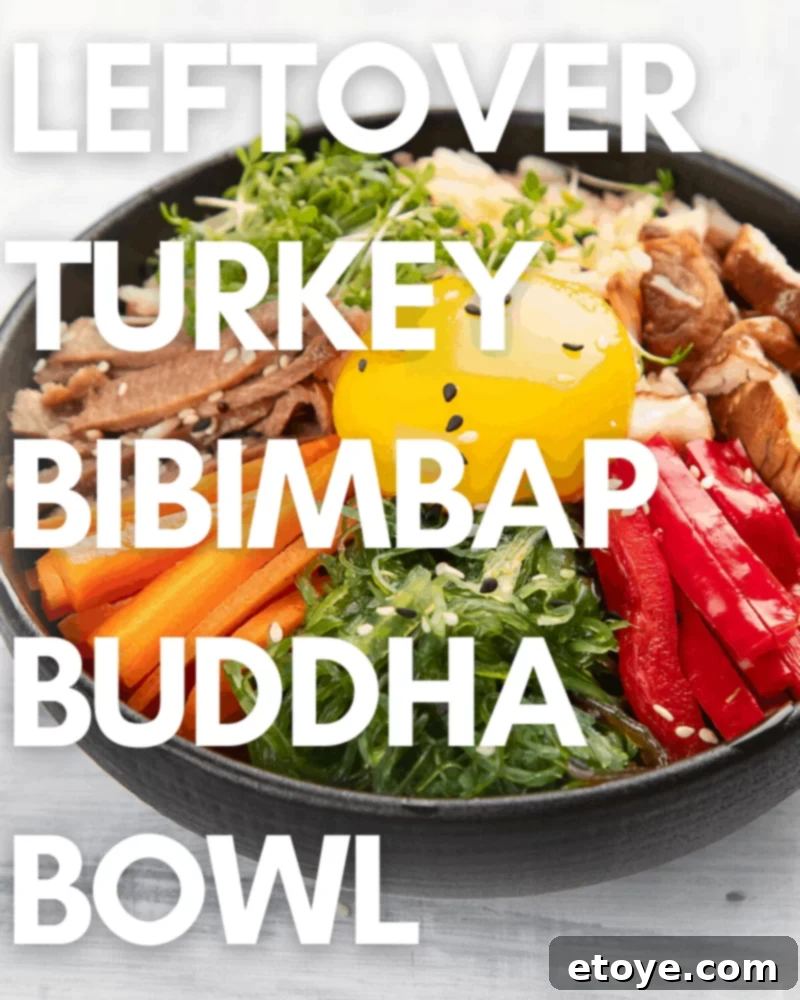The Thanksgiving feast is a culinary highlight, a time for abundance and cherished family gatherings. Yet, as the holiday glow fades, many of us are left with the age-old dilemma: what to do with the mountain of leftover turkey? While classic turkey sandwiches have their charm, after a meal rich in gravy and cranberry sauce, the palate often craves something entirely different, something vibrant, spicy, and fresh. This is where the magic of a Korean Bibimbap-inspired Buddha Bowl comes in – a delicious and healthy antidote to post-holiday food fatigue, offering a burst of flavor and a delightful texture contrast.
Imagine a colorful bowl brimming with crisp, fresh vegetables, tender leftover turkey, fluffy steamed rice, and crowned with a perfectly fried egg, all brought together by a bold, spicy Korean Gochujang sauce. This isn’t just another leftover dish; it’s a complete culinary transformation that promises to cleanse your palate and invigorate your senses. It’s an exciting journey from traditional American comfort food to the dynamic flavors of Korea, ensuring your leftover turkey finds a gloriously new and irresistible purpose.
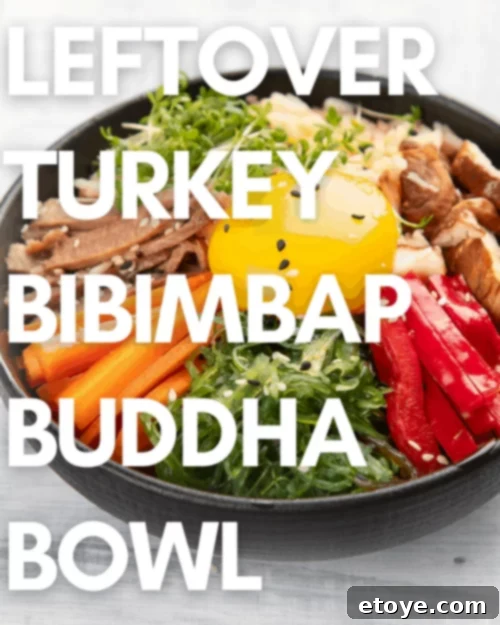
Revolutionizing Leftover Turkey Recipes: A Culinary Transformation

Our commitment extends beyond simply making delicious food; it’s about making smart food choices and minimizing waste, especially during the holidays. The festive season, while wonderful, often results in an abundance of food, leading to significant leftovers. Our goal is to provide creative, inspiring solutions that give new life to these ingredients, ensuring that nothing goes to waste and every meal feels fresh and exciting.
The golden rule for reinventing leftover turkey is simple yet crucial: ensure the new meal tastes COMPLETELY different from your original holiday spread. There’s a certain charm to the first serving of Thanksgiving dinner, but reheating the same flavors repeatedly quickly loses its appeal. Nobody wants to experience déja vu with their dinner for four nights in a row. Our approach focuses on transforming the turkey into something unrecognizable from its previous form, offering a fresh culinary experience that stands on its own.
This Bibimbap Buddha Bowl is just one gem in our collection of innovative leftover turkey recipes. Explore other exciting ideas to keep your post-holiday meals delicious and diverse:
- Leftover Turkey Thai Buddha Bowl
- Leftover Turkey Miso Ramen
- Leftover Turkey Cranberry BBQ Sandwiches
- Leftover Thanksgiving Cream of Turkey Soup with Garlic Croutons
- Leftover Turkey Cobb Salad
- Leftover Turkey and Stuffing Stuffed Squash
Understanding the Versatile Buddha Bowl

A Buddha Bowl, often celebrated for its aesthetic appeal and nutritional value, is essentially a wholesome, one-dish meal served in a single bowl. Its beauty lies in its simplicity and infinite adaptability. The concept encourages creativity, allowing you to combine various ingredients you have on hand, making it a perfect vehicle for using up those lingering leftovers. A typical Buddha Bowl is built upon a foundation of key components:
- Base Grains or Starch: This forms the hearty foundation of your bowl. Common choices include steamed rice (white or brown), quinoa, farro, couscous, or even sweet potato. It provides sustained energy and satisfying texture.
- Diverse Vegetables: The vibrant soul of the Buddha Bowl. These can be a mix of raw, cooked, roasted, or lightly blanched vegetables. Think crunchy cucumbers, shredded carrots, tender spinach, earthy mushrooms, bell peppers, or crisp radishes. Aim for a spectrum of colors, flavors, and textures for maximum appeal and nutritional benefit.
- Lean Protein: The primary source of satiety and muscle fuel. While we’re focusing on leftover turkey today, Buddha Bowls are incredibly versatile and can feature grilled chicken, tofu, tempeh, salmon, chickpeas, or lentils.
- Signature Sauce or Dressing: This is the unifying element that brings all the flavors together. It can be creamy, tangy, spicy, or savory, elevating the entire dish. Today, our Korean Gochujang sauce takes center stage, offering a bold and exciting flavor profile.
- Crunchy Topping: The final touch that adds textural contrast and an extra layer of flavor. Options include toasted nuts (peanuts, cashews), seeds (sesame, sunflower), crispy fried shallots, or even a sprinkle of fresh herbs.
The beauty of the Buddha Bowl is its inherent flexibility. It’s a fantastic method to transform small portions of various ingredients into a cohesive, satisfying meal, reducing food waste while promoting healthy eating. For this specific recipe, we are creating a delicious Bibimbap-inspired Buddha Bowl, featuring the rich flavors of Korea and making excellent use of your leftover Thanksgiving turkey.
What is Bibimbap? A Classic Korean Mixed Rice Dish
Bibimbap (pronounced BEE-beem-bop) is one of Korea’s most iconic and beloved dishes, literally translating to “mixed rice.” It’s not just a meal; it’s an experience, celebrated for its vibrant colors, diverse textures, and harmonious blend of flavors. Traditionally, Bibimbap is served as a bowl of warm white rice topped with an array of sautéed and seasoned vegetables (namul), a protein (often beef or tofu), a raw or fried egg, and the pièce de résistance – a generous dollop of Gochujang (Korean chili paste). Everything is then mixed together just before eating, creating a delightful symphony of tastes and sensations.
Our Bibimbap-inspired Buddha Bowl adapts this classic concept to perfectly suit your leftover turkey, creating a modern, convenient, and equally delicious meal. To create this flavorful and visually stunning bowl, here’s what you’ll need, beyond your basic pantry staples:
- Leftover Turkey: The star of our show! While ideal for Thanksgiving leftovers, this recipe is so delightful you might find yourself making it with other proteins like shredded chicken, beef, or even tofu any time of the year.
- Assorted Vegetables: Embrace the rainbow! Think thinly sliced cucumbers for freshness, daikon radishes for a peppery bite, vibrant scallions, tender spinach, and sweet carrots. The beauty is in using whatever colorful vegetables you have available in your fridge – a true testament to the anti-food waste philosophy of Buddha Bowls.
- Gochujang Drizzle: The heart and soul of this Korean-inspired dish, providing its distinctive spicy, savory, and slightly sweet flavor. This unique ingredient is what elevates the bowl from good to extraordinary.
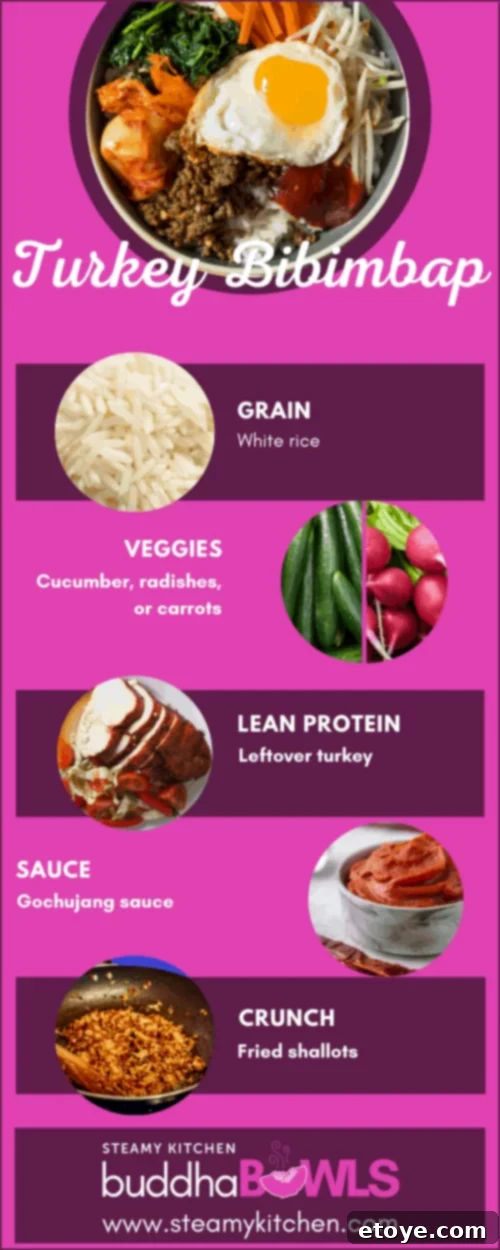
Gochujang: The Flavorful Secret Behind Korean Cuisine
Gochujang is much more than just a red pepper paste; it’s a fundamental ingredient in Korean cooking, revered for its complex flavor profile that is spicy, savory, slightly sweet, and deeply umami. Made from glutinous rice, fermented soybeans, and Korean red chili powder (gochugaru), it has a thick, sticky consistency and a beautiful deep red hue. Its fermentation process contributes to its rich, nuanced taste, making it an indispensable component in countless Korean dishes, from marinades and stews to dipping sauces and, of course, Bibimbap.
You can typically find Gochujang in the Asian foods aisle of most large supermarkets or, for a wider selection and often better prices, at your local Asian grocery store. It’s usually sold in distinctive red tubs or jars. For those who prefer a less spicy profile, or if Gochujang isn’t readily available, there are excellent alternatives:
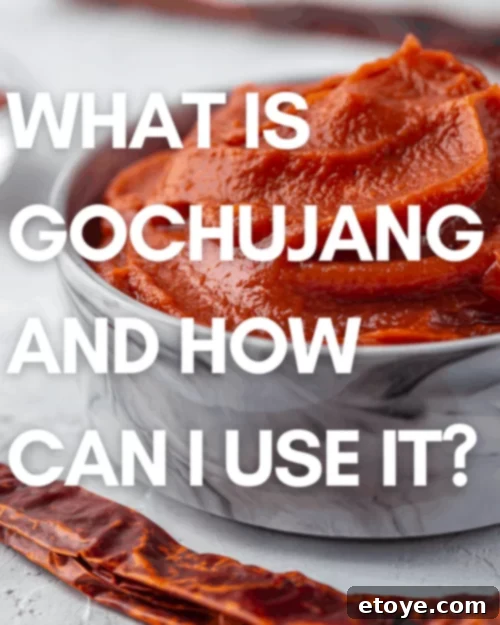
If you’re seeking a non-spicy, savory Korean paste, look for Doenjang. This fermented soybean paste is similar to Japanese miso but typically has a bolder, more pungent flavor. It’s a staple in Korean soups and stews and offers a fantastic umami depth without any heat. If Doenjang is also hard to find, Miso paste (especially red or brown miso) makes for a suitable substitute. Both Doenjang and miso are derived from fermented beans, providing that essential savory, umami-rich foundation to any dish. These pastes are fantastic for quick flavor boosts in sauces, dressings, and marinades.
A great advantage of these fermented pastes is their excellent shelf life. Once opened, store Gochujang, Doenjang, and Miso paste tightly sealed in the refrigerator. With proper storage, they can remain fresh and flavorful for up to a year, making them valuable long-term additions to your culinary arsenal.
Crafting the Perfect Korean Gochujang Drizzle
The Gochujang drizzle is the undeniable hero of this Bibimbap Buddha Bowl, ingeniously transforming your familiar leftover turkey into an exciting, distinctly Korean culinary experience. Its vibrant flavor profile is the secret to making this meal taste completely different and utterly irresistible. Here’s how to whip up this essential sauce and infuse your turkey with its magic:
- Prepare the Sauce: In a medium-sized mixing bowl, combine all the ingredients for your Gochujang drizzle. Whisk them vigorously until they are thoroughly blended and smooth. This ensures an even distribution of its spicy, savory, and sweet notes.
- Marinate the Turkey: Add your cooked, shredded, or diced leftover turkey directly into the bowl with the prepared Gochujang sauce. Toss the turkey gently but thoroughly, ensuring every piece is coated in the flavorful marinade. Let it rest on the counter for a few minutes while you gather and prepare your other bowl components. This brief marination allows the turkey to absorb the delicious Korean flavors, enhancing its taste and texture.
- Final Drizzle for Extra Kick: After you’ve assembled your Buddha Bowls with all the fresh vegetables, rice, and egg, remember to reserve some of that glorious Gochujang drizzle. A final generous drizzle over the top of your assembled bowl right before serving provides an extra layer of flavor, a beautiful sheen, and a potent kick that ties everything together perfectly.

Leftover Turkey Bibimbap Buddha Bowl Recipe
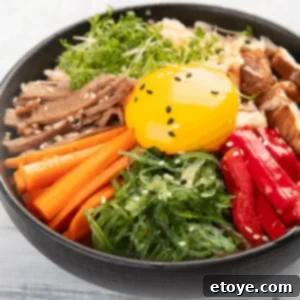
Leftover Turkey Bibimbap Buddha Bowl
This innovative leftover turkey recipe reimagines Korean Bibimbap (BEE-beem-bop), a vibrant and classic dish of steamed rice with colorful vegetables. It’s the perfect way to transform your holiday leftovers into a fresh, exciting, and healthy meal.
15 mins
5 mins
Main Course
Korean
4
Ingredients
- Gochujang Drizzle (recipe below or separate link)
- Leftover Thanksgiving turkey, shredded or diced
- 2 cups cooked white rice
- 3 packed cups fresh spinach
- 4 large eggs, fried (with runny yolks preferred)
- Fresh veggies, sliced thinly (e.g., cucumber, daikon radish, carrots, bell peppers)
- Crunchy topping (e.g., fried shallots, toasted peanuts, sesame seeds)
Instructions
- In a medium bowl, whisk together all the ingredients for the Gochujang Drizzle until well combined. Add the shredded or diced leftover turkey to the bowl and toss to coat evenly. Let the turkey marinate on the counter while you prepare the remaining ingredients.
- Place a large skillet or pan over medium-high heat. Drizzle in a small amount of cooking oil. Once hot, add the fresh spinach and stir-fry, tossing frequently, for about 2 minutes, or until the spinach has fully wilted. Transfer the wilted spinach to a plate and set aside.
- Wipe the pan clean and return it to medium heat. Swirl in a little more cooking oil. Carefully crack the eggs into the pan and cook without stirring for approximately 3 minutes, or until the egg whites are set around the edges. Cover the pan, reduce the heat to medium-low, and cook for an additional 1-2 minutes until the egg whites are cooked through but the yolks remain wonderfully runny. Remove the fried eggs from the pan and set them aside on a plate.
- To assemble your Buddha Bowls, evenly divide the cooked rice among four serving bowls. Artfully arrange the marinated turkey, wilted spinach, and thinly sliced fresh vegetables on top of the rice in separate sections. Crown each bowl with a perfectly fried egg. Drizzle any remaining Gochujang sauce over each bowl for an extra burst of flavor before serving.
bibimbap, buddha bowl, leftovers, turkey, korean food, gochujang
Tried this recipe?
Let us know how it was!
Why This Leftover Turkey Bibimbap Buddha Bowl is a Must-Try
This Leftover Turkey Bibimbap Buddha Bowl isn’t just another way to use up holiday leftovers; it’s a culinary triumph that tackles several challenges at once. Firstly, it’s a powerful tool in the fight against food waste. Instead of discarding perfectly good turkey or suffering through repetitive meals, you transform it into something entirely new and exciting. This recipe encourages mindful eating and resourceful cooking, extending the life of your ingredients and your food budget.
Secondly, it’s incredibly healthy and customizable. Buddha Bowls are inherently packed with nutrients from fresh vegetables, lean protein, and wholesome grains. You have complete control over the ingredients, allowing you to tailor it to your dietary preferences or what’s available in your fridge. Want more greens? Add them! Prefer brown rice? Go for it! This adaptability makes it a truly versatile meal that can be enjoyed by everyone.
Finally, and perhaps most importantly, it’s absolutely delicious. The vibrant, spicy, and savory notes of the Gochujang sauce beautifully complement the tender turkey, while the fresh vegetables add a delightful crunch and brightness. The runny yolk of the fried egg creates a rich, creamy sauce when mixed, tying all the flavors and textures together. It’s a meal that feels indulgent yet light, satisfying every craving after the heavy holiday feast.
So, the next time you find yourself with leftover turkey, step outside the sandwich box. Embrace the bold flavors of Korea and create this Leftover Turkey Bibimbap Buddha Bowl. It’s a simple, quick, and incredibly rewarding way to enjoy your leftovers, proving that transformation can be truly delicious. We encourage you to experiment with your favorite vegetables and toppings, making this recipe truly your own. Share your creations and inspire others to give their holiday leftovers a vibrant new beginning!
